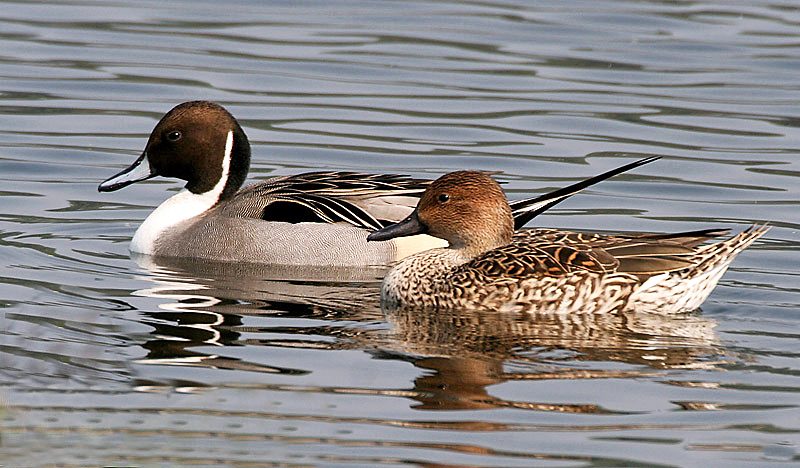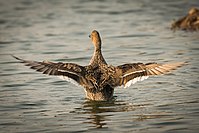
Northern pintail
The pintail or northern pintail (Anas acuta) is a duck species with wide geographic distribution that breeds in the northern areas of Europe and across the Palearctic and North America. It is migratory and winters south of its breeding range to the equator. Unusually for a bird with such a large range, it has no geographical subspecies if the possibly conspecific duck Eaton's pintail is considered to be a separate species.
This is a large duck, and the male's long central tail feathers give rise to the species' English and scientific names. Both sexes have blue-grey bills and grey legs and feet. The drake is more striking, having a thin white stripe running from the back of its chocolate-coloured head down its neck to its mostly white undercarriage. The drake also has attractive grey, brown, and black patterning on its back and sides. The hen's plumage is more subtle and subdued, with drab brown feathers similar to those of other female dabbling ducks. Hens make a coarse quack and the drakes a flute-like whistle.
The northern pintail is a bird of open wetlands which nests on the ground, often some distance from water. It feeds by dabbling for plant food and adds small invertebrates to its diet during the nesting season. It is highly gregarious when not breeding, forming large mixed flocks with other species of duck. This duck's population is affected by predators, parasites and avian diseases. Human activities, such as agriculture, hunting and fishing, have also had a significant impact on numbers. Nevertheless, owing to the huge range and large population of this species, it is not threatened globally.
Taxonomy[edit]
This species was first described by Carl Linnaeus in his landmark 1758 10th edition of Systema Naturae as Anas acuta.[2] The scientific name comes from two Latin words: anas, meaning "duck", and acuta, which comes from the verb acuere, "to sharpen"; the species term like the English name, refers to the pointed tail of the male in breeding plumage.[3] Within the large dabbling duck genus Anas,[2] the northern pintail's closest relatives are other pintails, such as the yellow-billed pintail (A. georgica) and Eaton's pintail (A. eatoni). The pintails are sometimes separated in the genus Dafila (described by Stephens, 1824), an arrangement supported by morphological, molecular and behavioural data.[4][5][6] The famous British ornithologist Sir Peter Scott gave this name to his daughter, the artist Dafila Scott.[7]
Eaton's pintail has two subspecies, A. e. eatoni (the Kerguelen pintail) of Kerguelen Islands, and A. e. drygalskyi (the Crozet pintail) of Crozet Islands, and was formerly considered conspecific with the Northern Hemisphere's northern pintail. Sexual dimorphism is much less marked in the southern pintails, with the male's breeding appearance being similar to the female plumage. Unusually for a species with such a large range, northern pintail has no geographical subspecies if Eaton's pintail is treated as a separate species.[8]
A claimed extinct subspecies from Manra Island, Tristram's pintail, A. a. modesta, appears to be indistinguishable from the nominate form.[9] The three syntype specimens of Dafila modesta Tristram (Proceedings of the Zoological Society of London, 1886, p.79. pl. VII), the extinct subspecies, are held in the vertebrate zoology collections of National Museums Liverpool at World Museum, with accession numbers NML-VZ T11792 (male immature), NML-VZ T11795 (female adult) and NML-VZ T11797 (female adult).[10] The specimens were collected by J. V. Arundel in Sydney Island (Manra Island), Phoenix Islands in 1885 and came to the Liverpool national collection via Canon Henry Baker Tristram's collection which was purchased in 1896.[10]
The northern pintail is a fairly large duck with a wing chord of 23.6–28.2 cm (9.3–11.1 in) and wingspan of 80–95 cm (31–37 in).[11] The male is 59–76 cm (23–30 in) in length and weighs 450–1,360 g (0.99–3.00 lb), and therefore is considerably larger than the female, which is 51–64 cm (20–25 in) long and weighs 454–1,135 g (1.001–2.502 lb).[12] The northern pintail broadly overlaps in size with the similarly widespread mallard, but is more slender, elongated and gracile, with a relatively longer neck and (in males) a longer tail. The unmistakable breeding plumaged male has a chocolate-brown head and white breast with a white stripe extending up the side of the neck. Its upperparts and sides are grey, but elongated grey feathers with black central stripes are draped across the back from the shoulder area. The vent area is yellow, contrasting with the black underside of the tail,[8] which has the central feathers elongated to as much as 10 cm (3.9 in). The bill is bluish and the legs are blue-grey.[13]
The adult female is mainly scalloped and mottled in light brown with a more uniformly grey-brown head, and its pointed tail is shorter than the male's; it is still easily identified by its shape, long neck, and long grey bill.[8] In non-breeding (eclipse) plumage, the drake pintail looks similar to the female, but retains the male upperwing pattern and long grey shoulder feathers. Juvenile birds resemble the female, but are less neatly scalloped and have a duller brown speculum with a narrower trailing edge.[14]
The pintail walks well on land, and swims well.[8] In water, the swimming posture is forward leaning, with the base of the neck almost flush with the water.[13] It has a very fast flight, with its wings slightly swept-back, rather than straight out from the body like other ducks. In flight, the male shows a black speculum bordered white at the rear and pale rufous at the front, whereas the female's speculum is dark brown bordered with white, narrowly at the front edge but very prominently at the rear, being visible at a distance of 1,600 m (1 mi).[14]
The male's call is a soft proop-proop whistle, similar to that of the common teal, whereas the female has a mallard-like descending quack, and a low croak when flushed.[8]
Status[edit]
The northern pintail has a large range, estimated at 41,900,000 km2 (16,200,000 sq mi), and a population estimated at 4.8–4.9 million individuals. The IUCN has categorised the northern pintail as not being threatened globally,[1] however it is endangered in Europe.[37]
In the Palaearctic, breeding populations are declining in much of the range, including its stronghold in Russia. In other regions, populations are stable or fluctuating.[38]
Pintails in North America at least have been badly affected by avian diseases, with the breeding population falling from more than 10 million in 1957 to 3.5 million by 1964. Although the species has recovered from that low point, the breeding population in 1999 was 30% below the long-term average, despite years of major efforts focused on restoring the species. In 1997, an estimated 1.5 million water birds, the majority being northern pintails, died from avian botulism during two outbreaks in Canada and Utah.[25]
The northern pintail is one of the species to which the Agreement on the Conservation of African-Eurasian Migratory Waterbirds (AEWA) applies,[39] but it has no special status under the Convention on International Trade in Endangered Species of Wild Fauna and Flora (CITES), which regulates international trade in specimens of wild animals and plants.[12]






